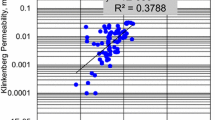Abstract
Relative permeability and resistivity index are important parameters in petrophysics experiments and reservoir evaluations. According to the results of previous studies, there exists a relationship between resistivity index and relative permeability in in situ reservoir condition and a lot of transformation models were established. In this paper, we compared the relative permeability which was calculated from the resistivity index measured in different conditions (in situ reservoir condition and conventional condition), and the result shows that the relative permeabilities are similar. If core samples are fragile and not resistant to high temperature or high pressure, it is possible to use resistivity index measured in conventional condition to get the relative permeability which provides a convenient way for experimental measurement and reservoir evaluation. In practical applications, the results show that the pore structure make a great influence on the relationship between wetting phase tortuosity ratio and resistivity index. Therefore, in this study we took the difference of pore structure into account when deciding model parameters by core analysis, and the verification results are basically consistent with the laboratory measurement results.













Similar content being viewed by others
References
Archie GE (1942) The electrical resistivity log as an aid in determining some reservoir characteristics. J Trans AIME 146:54–62
Brooks RH, Corey AT (1966) Properties of porous media affecting fluid flow. J Irrig Drain Div 92:61–90
Burdine NT (1953) Relative permeability calculations from pore size distribution data. J Pet Technol 5:71–78
Ma D, Liu C, Cheng C (2015) New relationship between resistivity index and relative permeability. J Energy Resour Technol 137:032904
Ge X, Fan Y, Xing D, Chen J, Cong Y, Liu L (2015) Predicting the relative permeability of water phase based on theory of coupled electricity-seepage and capillary bundle model. J Open Pet Eng J 8:344–349
Kleinberg RL, Flaum C, Griffin DD, Brewer PG, Malby GE, Peltzer ET, Yesinowski JP (2003) Deep sea NMR: methane hydrate growth habit in porous media and its relationship to hydraulic permeability, deposit accumulation, and submarine slope stability. J Geophys Res Solid Earth 108:B10
Li K (2007) A new method for calculating two-phase relative permeability from resistivity data in porous media. J Trans Porous Media 74:21–33. doi:10.1007/s11242-007-9178-4
Li K (2011) Interrelationship between resistivity index, capillary pressure and relative permeability. J Transp Porous Media 88:385–398
Li K, Firoozabadi Abbas (2000) Phenomenological modeling of critical condensate saturation and relative permeabilities in gas condensate systems. J SPEJ. 5:138–147
Li K, Horne RN (2004) Experimental study of gas slippage in two-phase flow. J SPEREE 7:409–414
Li K, Horne RN (2006) Comparison of methods to calculate relative permeability from capillary pressure in con-solidated water-wet porous media. J Water Resour Res 42:W06405. doi:10.1029/2005WR004482
Pairoys F, Al-Zoukani A, Keskin A (2013) Interrelationship between resistivity and relative permeability of a carbonate rock during drainage and imbibition experiments. In: Society of Core Analysts, SCA2013-46, Napa Valley, USA
Pirson SJ, Boatman EM, and Nettle RL (1963) Prediction of relative permeability characteristics of intergranular reservoir rocks from electrical resistivity measurements. In: SPWLA 4th Annual Logging Symposium. Society of Petrophysicists and Well-Log Analysts
Purcell WR (1949) Capillary pressures-their measurement using mercury and the calculation of permeability. J Trans AIME 1:39–48
Sanyal SK (1971) The effect of temperature on electrical resistivity and capillary pressure behavior of porous media. Dissertation, Stanford University
Szabo MT (1974) New methods for measuring imbibition capillary pressure and electrical resistivity curves by centrifuge. J SPEJ 14:243–252
Thornton OF (1949) A note on the valuation of relative permeability. J Trans AIME 186:328–328
Toledo GT, Novy RA, Davis HT, Scriven LE (1994) Capillary pressure, water relative permeability, electrical conductivity and capillary dispersion coefficient of fractal porous media at low wetting phase saturation. SPE Adv Technol 2:136–141
Zhang Z, Weller A (2014) Fractal dimension of pore-space geometry of an Eocene sandstone formation. J Geophysics 79:D377–D387
Acknowledgments
This work is supported in part by the National Natural Science Foundation of China under Grant 41174096.
Author information
Authors and Affiliations
Corresponding author
Rights and permissions
About this article
Cite this article
Guo, Yh., Pan, Bz. & Liu, Wb. A research on the relationship between resistivity index and relative permeability at different measurement conditions based on the pore structure. Environ Fluid Mech 16, 1129–1141 (2016). https://doi.org/10.1007/s10652-016-9469-9
Received:
Accepted:
Published:
Issue Date:
DOI: https://doi.org/10.1007/s10652-016-9469-9




